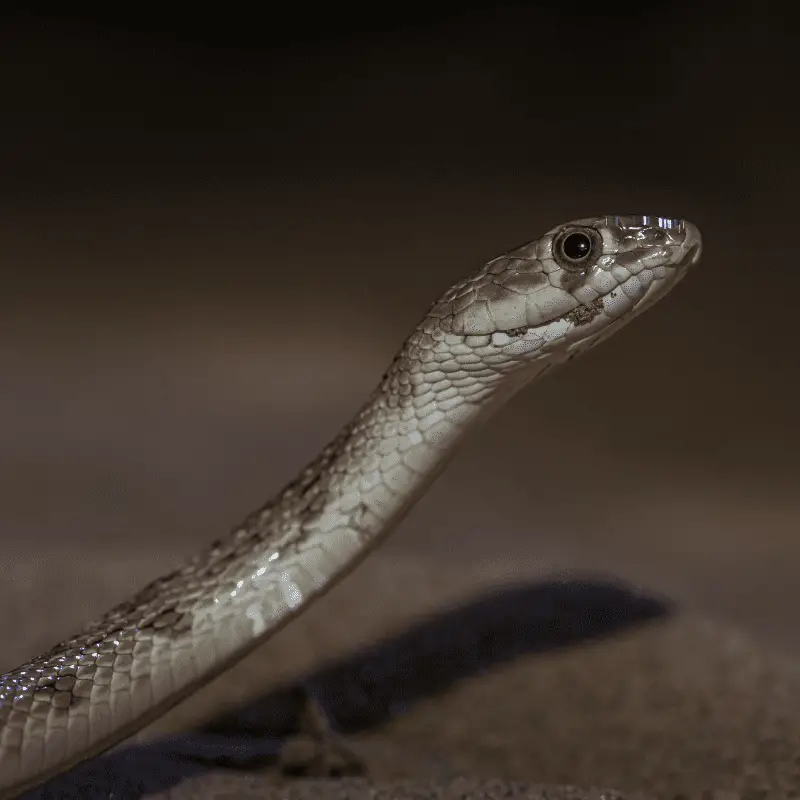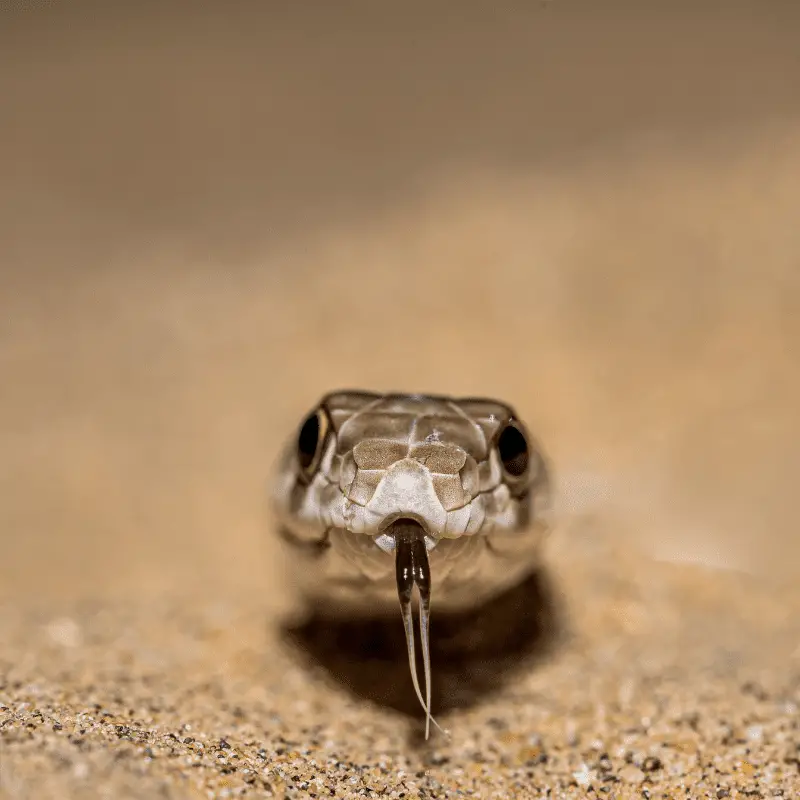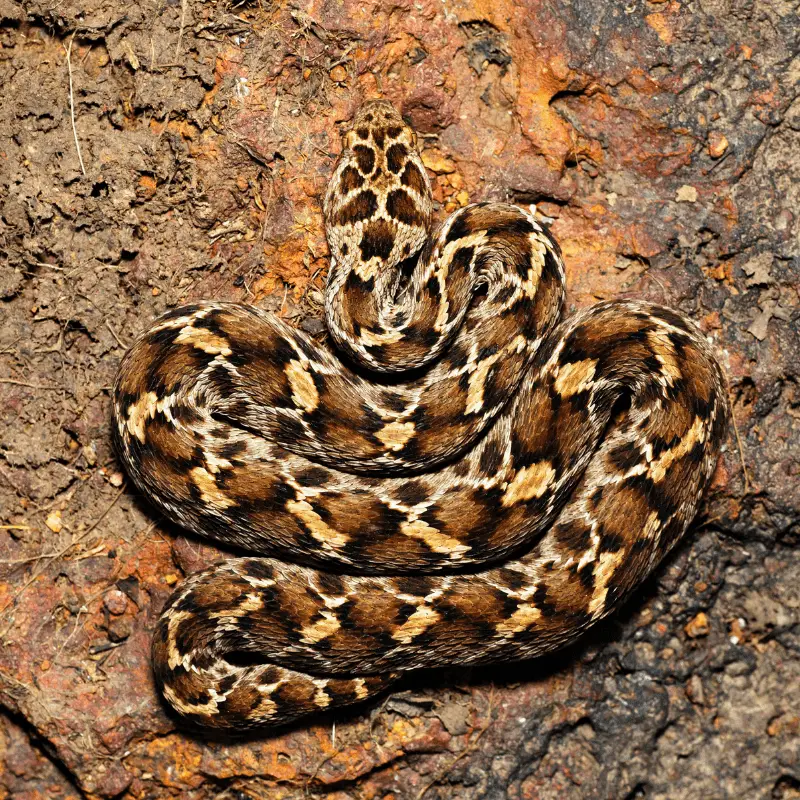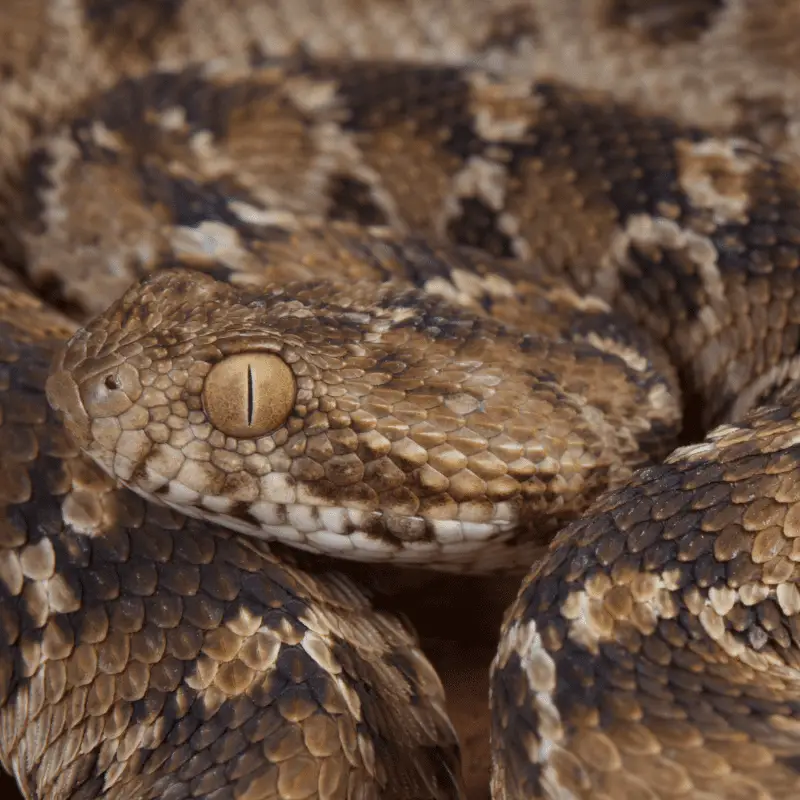The saw-scaled viper is one of the small venomous snakes that live in parts of Central Asia and the Middle East. It is one of the relatively tiny snakes that has highly potent venom. The saw-scaled vipers are the minor representative of the Big Four Snakes, the four species of snakes cause the maximum snakebite cases and deaths per year. When threatened, these snakes make a unique raspy sound that makes them one of the most enigmatic members of the Big Four snakes.
- Common Names: Saw-scaled viper, Indian saw-scaled viper, little Indian viper.
The venom yield from each of the specimens differs significantly. The quantity of venom injected per bite also varies. The potent venom of the saw-scaled viper has created havoc for medical experts that they had to produce nine different anti-venom to fight it off.
Species Overview
- Species: E. carinatus
- Genus: Echis
- Family: Viperidae
- Life span: 23 Years
- Length: 38-40 cm
Geographical Region
The saw-scaled vipers are generally found in some parts of Central Asia and the Middle East. The snake species is especially endemic to the Indian subcontinent. In the Indian subcontinent, these snakes are found in India, Bangladesh, Sri Lanka, and Pakistan. In the Middle East, the saw-scaled vipers are found in the eastern side of the United Arab Emirates, Oman, Iraq, and the southwestern section of Iran. In the central part of Asia, these snakes are often found in Uzbekistan, Afghanistan, Turkmenistan, and Tajikistan.

The saw-scaled vipers love to live in the arid regions and the dry savannas. However, the snakes that live in Indian Subcontinents love to live in the semi-deserts, rain forests, grasslands, moist deciduous forests, scrublands, and even complete deserts. These snakes are often found in agricultural fields, rocky terrains, open plains, and scrubs. These snakes love to remain under the loose rocks, leaf litters, caves, piles, and mounds. Some sun species of the saw-scaled vipers are also found in parts of mountainous areas of Baluchistan.
Appearance
The saw-scaled vipers come with a stout body and a pear-shaped head, easily distinguished from their neck region. The elliptical pupils of the eyes of the snake make them look significantly dangerous. The short tail and the distinctive scales are some other features that make the snake look different from the others.
The saw-scaled viper snakes got their name from the organised rows of these strong and keeled scales. The serrated scales are obliquely arranged on the sides of their bodies. Unlike the other snakes, the scales of the saw-scaled vipers are arranged in an upward manner.
Whenever these snakes feel threatened, they bunch their bodies together and create a tight S-shape. After that, they move slowly so that the scales rub together. The rubbing of the scales makes the raspy sound people can hear whenever a saw-scaled viper is nearby.
This unique method of making the raspy sound is known as stridulation.
The adult snakes grow up to 1 to 3 feet in length. These snakes come in various shades of colours, such as grey, brown, and orange shades. The snakes come with frantic darker blotches on the top of their bodies, and some of the snakes even have lateral spots.
The side-winding locomotion is yet another evolutionary adaptation of the snakes. As they mostly live in the arid regions, the side-winding movement helps the snakes to move efficiently on the sandy substrate, which offers no or little traction. It is one of the features of the saw-scaled vipers that enable us to identify them from the rest of the snake species.
The Distribution
The Saw-scaled viper snake group currently includes twelve different species. In India, you can find one species of saw-scaled vipers along with its two other subspecies.
However, there are high chances that the researchers can create further taxonomic divisions. They can split them into even more species within the country.
The group of snakes is believed to be the cause of the most number of snake bites in the world. In Africa, the saw-scaled vipers cause the highest number of snakebite deaths. While these snakes do not cause many fatalities in India, their bites can cause a lot of tissue damage. If not treated promptly, the victim of the snake bite can lose its limb permanently.
Habits and Lifestyle
These snakes are by nature crepuscular or nocturnal. However, you can spot these snakes during the daylight hours as well. The saw-scaled vipers generally hide in the mammal burrows during the daytime. In the desert areas, these snakes may bury themselves in the sand while keeping their head out. The Indian variant is often more active during the humid nights or the rainy season. These snakes can also climb the shrubs or bushes, sometimes as high as 2 meters above the ground. When it rains, 80% of the saw-scaled vipers climb up the tree.

While the side-winding is one of the significant features of these snakes, they can utilise other locomotions as well. However, the side-winding helps the snakes move alarmingly quickly in their sandy habitat. This type of locomotion also allows them to stop getting overheated too quickly. As they only have two contact points with the surface, they can move pretty swiftly and effectively.
The cryptic lifestyle and the deep inclination of hiding instead of fleeing make these snakes particularly dangerous. The small body of the saw-scaled viper enables them to hide under even a single leaf or inside the smallest of ground cover. That’s what makes the people walking barefoot the most common victims of these snakes.
It is also one of the biggest reasons why people walking barefoot are at the most considerable risk from the snake bite. The snake is highly aggressive and inconspicuous as well. When threatened, the snake takes a figure of eight, with its head in the centre. This position helps the snake to lash out like a powerful spring to bite a human or an animal.

Nutrition and Diet
These snakes live on different diets in various regions across their range. The diet of the snake changes depending on its lifespan as well. The saw-scaled vipers found in the southern parts of India are known for consuming insects, invertebrates, and small reptiles. The snakes found in other parts of the country feed on the scorpions. These snakes are also known for feeding on tiny shrews or rodents. The juvenile saw-scaled vipers generally feed exclusively on the small invertebrates and insects. As they grow old, they incorporate the small reptiles and amphibians into their diet.
Reproduction
Unlike other snakes, the mating season of the saw-scaled viper is during the winter months. The exciting thing about the saw-scaled viper is that they do not lay eggs even though each species belongs to the same genus, Echis. Some species of the saw-scaled vipers give birth to the snakelets.
The neonates of the Indian variant of the saw-scaled vipers are not bigger than the average earthworms. These neonates shed their skins for the first time only after a day or so after they were born. Their mother does not care for them. So, from the very beginning, these snakes are on their own. That makes these small neonates one of the favourite prey of the frogs, birds, and some other mammals. Even some spiders and scorpions also feed on these neonates.
How many snakes do a saw-scaled viper give birth to each time?
The clutch size of these snakes is not that large either. A mother saw-scaled snake gives birth to ten to fifteen neonates. For the saw-scaled vipers, fifteen neonates is a large-sized clutch. On average, about five to six neonates help to form a clutch of these snakes.
- On average – five to six neonates
Threats
Right now, there is no threat to the saw-scaled vipers. However, simple things, like urbanisation or a change of landscape, can make the entire population vanish pretty quickly.
The Venom of Saw-Scaled Vipers
The venom of the saw-scaled vipers is full of cytotoxins and hepatotoxins. That is why the venom stops the blood from clotting and can cause significant tissue and cell damages. The problem with the venom of the saw-scaled vipers is that it changes from one specimen to the next. The researchers think that the variable diet is the leading cause of these changing variations of venom. To fight off the snakebite deaths, the doctors have formulated nine different anti-venoms for saw-scaled vipers alone.
Within minutes of the bite, the bitten area swells, and the pain starts. The blood coagulation and bleeding defects follow closely after that. It can lead to hypovolemic shock. Blood clotting troubles are among the most prevalent issues and can lead to acute kidney issues in the victim. Almost all the victims of snake bites experience anuria and oliguria within a couple of hours of the snake bites. Problems can develop as late as six days after the biting incident—intravenous hydration and anti-venom therapy are needed within the snake bite hours.
How to avoid a Saw-scaled viper bite?
As the saw-scaled vipers often hide in the ground, wearing protective gear, like rubber boots, while walking is one of the easiest ways to avoid snake bites. Make sure to use a flashlight if you are going out in a saw-scaled viper prevalent zone. Even if you encounter a snake, do not disturb it and leave the snake as it is. Also, do not try to handle snakes in the same way shown on television. Handling the snakes is one of the most skilled jobs, which you cannot perform as skillfully as the experts.
What to do if you get bit by a snake?
If you or anyone you know gets bitten by a snake, try to see what type of snake it is; remember the shape and snake’s colour. This information can be crucial during the treatment process. Try to keep the anxiety level of the bitten person to a minimum. As the venom spreads through blood, not getting stressed can slow down the spread.
Take the victim of the snake bite to the nearest possible hospital. If you do not have any hospitals or health care centres nearby, try to keep the bitten part of the body below the heart level. Wash the wound with warm soapy water and dress the bitten area with dry and clean dressings.
What You Should Not Do
Do not try to pick up the saw-scaled viper once you are bitten. Do not try to trap the snake as it will put someone else at risk. Do not try to tourniquet the area above the snake bite. Never slash the bitten area with a knife or other sharp objects, and do not ever try to suck out the venom. Do not use ice or water on the bitten area and avoid drinking alcohol. Also, avoiding caffeinated beverages may be a good option as well.
Reminder – Snake Bites
Saw-scaled vipers, and all the other snakes, for that matter, only bite when they feel highly threatened. So if you spot a snake, then maintain a safe distance till the professional rescuers reach the place. If you confront a snake in the wild, you should slowly back off so that the snake does not feel threatened in any way.
Many of the snake bites are accidental. That means the snake did not intend to bite you when it did. The snakes only bite humans intentionally when they are provoked. Otherwise, all the other bites are accidental.
The snakes do not take acts of revenge and follow you around. The snakes do not have the memory capacity to remember or recognise a person.

